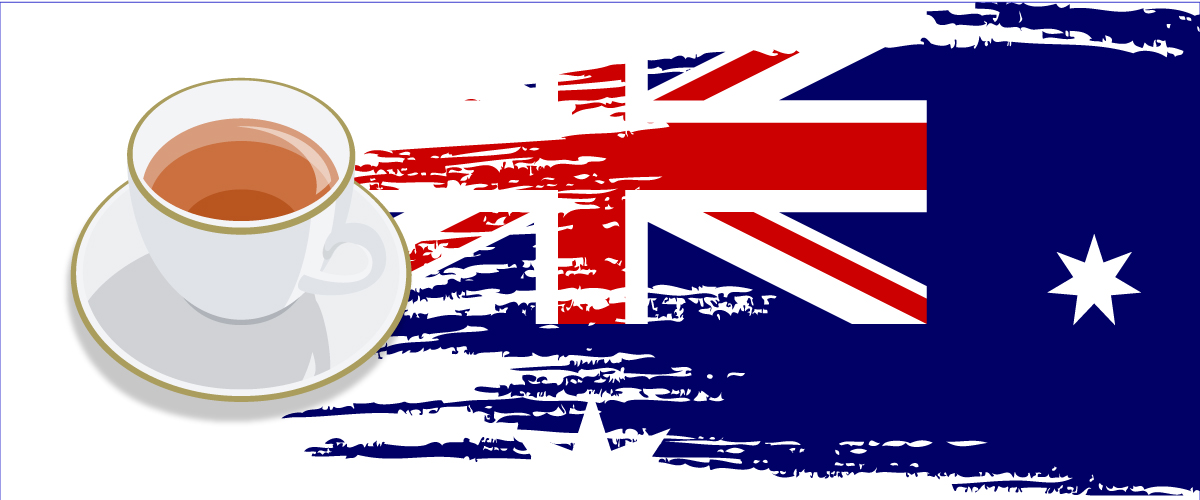Australian native tea trees were no match for Camellia sinensis when it came to a colonial cuppa.
‘Switch to Tea’ urges the billboard. You can see it from the Sydney Harbour Bridge crossing north to south by rail or road, peeking up from a building in The Rocks, the historical part of the harbour city.
The building is less than a century old but qualifies for heritage listing—a concept, I admit, which amuses those from nations with much older built histories. It’s called The Bushells Building, after Philip Howard Bushell, who brought his father’s tea business to Sydney, and the billboard itself has been restored under the guidance of the New South Wales Heritage Office.

Although Indigenous Australians drank a herbal infusion made of Leptospernum scoparium, commonly known as the tea tree, Australia did not see tea from Camellia sinensis in any great quantities* until British colonisation. Here are some of Australia’s tea pioneers.
Alfred Thomas Bushell (1833-1910)
Opened Australia’s first tea shop
Bushell senior’s wife Agnes’ family was from the British tea trade, Brooke Bond, famous for brands such as PG Tips. Bushell traded tea in Sydney but it was not until Agnes’ death that he made a career change. He moved north to Brisbane, Queensland, and in 1883 opened Australia’s first tea shop with its signature blend of smooth, full-flavoured black tea.
The blend became popular and led Bushell’s sons Philip and Walter to take it south of Sydney (1890) and Melbourne (1899), where they progressed from selling the tea at roadside stalls to conducting wholesale trade.
Alfred passed away in 1910 and his sons subsequently publicly listed the company as Bushells Ltd, eventually opening headquarters in The Bushells Building in 1925. In 1978 the Bushell family sold their shares to their cousins who were the majority shareholders in Brooke Bond, which was later bought out by Unilever.
James Griffiths (1850-1925)
Grew Australia’s first commercial tea crop
Another English immigrant, James Griffiths, also saw success in the tea trade before becoming a pioneer in another sense. Griffiths Brothers Tea and Coffee, which James ran with his brother John, distributed tea, coffee and cocoa in Melbourne, Victoria, and then to much of the east coast of Australia. He then turned to tea production.
While four brothers—James, Herbert, Leonard and Sidney Cutten—attempted a tea plantation at Bingil Bay in North Queensland (now the site of the Nerada Tea plantation) during the 1880s, their crop was deemed a failure and never commercialised until a subsequent owner realised the plantation’s potential in the 1950s. Another grower from Narre Warren in Victoria reportedly grew and sold tea before Griffiths but his identity remains a mystery, and so Griffiths by default receives the title of the first in Australia to produce a commercial tea crop, which he grew at a farm in the Dandenong Ranges, outside Melbourne, and marketed in 1901.
In the Traralgon Record newspaper on 15th January 1901, Griffiths described his tea: “… the broken Orange Pekoe was very choice, fresh and flavory; the Pekoe and Souchong also being of a good useful character.”
Unfortunately, it sounds like the high cost of labour prohibited him from continuing this pursuit. To this day, however, Australia’s primary tea-growing areas are Far North Queensland and the temperate regions of Victoria.
Mei Quong Tart (1850-1903)
Opened Australia’s first teahouse
Born in China but transported to the gold fields of New South Wales at age nine accompanying an uncle, Mei Quong Tart became a popular Sydney figure and a crucial bridge between British Australia and its Chinese immigrants.
Although he initially made money through investing in gold claims, in 1881, after a trip to China to see his family, he began to import tea. He initially opened a small teahouse and then when it proved popular, he established the Loong Shan Tea House in central Sydney in 1889.
The Loong Shan was well-regarded by government officials and high society but it was the ladies of Sydney who truly appreciated having somewhere reputable to meet; the tearooms have long been regarded as the engine room for the women’s suffrage movement in Australia.
While the Glasshouse Shopping Centre and its carpark now stands on the site of the former Loong Shan, you can still ‘visit’ Quong Tart in the suburb of Ashfield, where he lived and died. His mansion has been turned into an aged care facility specialising in Chinese seniors and a monument to him has been erected in Hercules Street, outside the railway station. I pass it sometimes when I go to get bubble tea across the road.
*Some Indigenous nations may have encountered tea via Dutch explorers.

